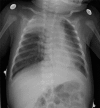Respiratory syncytial virus infection and bronchiolitis
- PMID: 25452661
- PMCID: PMC5029757
- DOI: 10.1542/pir.35-12-519
Respiratory syncytial virus infection and bronchiolitis
Erratum in
-
Correction.Pediatr Rev. 2015 Feb;36(2):85. doi: 10.1542/pir.36-2-85. Pediatr Rev. 2015. PMID: 25646315 Free PMC article. No abstract available.
Figures





References
-
- Ralston S, et al. Clinical Practice Guideline: The Diagnosis, Management, and Prevention of Bronchiolitis. Pediatrics. 2014;134(5):e1474–e1502. Accessed October 28, 2014, at: http://pediatrics.aappublications.org/content/134/5/e1474.full - PubMed
-
- Hall CB, Douglas RG., Jr Modes of transmission of respiratory syncytial virus. J Pediatr. 1981;99(1):100–103 - PubMed
-
- Gadomski AM, Bhasale AL. Bronchodilators for bronchiolitis. Cochrane Database Syst Rev. 2006;3(3):CD001266. - PubMed
-
- Patel H, Platt R, Lozano JM, Wang EE. Glucocorticoids for acute viral bronchiolitis in infants and young children. Cochrane Database Syst Rev. 2004; (3):CD004878. - PubMed
Publication types
MeSH terms
Substances
Grants and funding
LinkOut - more resources
Full Text Sources
Other Literature Sources
Medical

